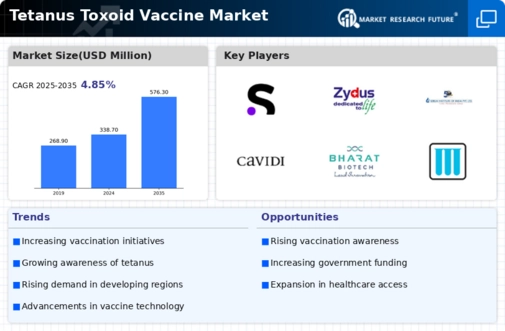Market Growth Projections
The Global Tetanus Toxoid Vaccine Market Industry is projected to experience substantial growth over the coming years. With a market value of 338.7 USD Million in 2024, it is anticipated to reach 576.3 USD Million by 2035, reflecting a compound annual growth rate (CAGR) of 4.95% from 2025 to 2035. This growth trajectory is influenced by various factors, including rising awareness of vaccination, government initiatives, and technological advancements. The increasing focus on immunization as a critical component of public health strategies further supports this upward trend, indicating a promising future for the market.
Government Initiatives and Policies
Government initiatives play a crucial role in shaping the Global Tetanus Toxoid Vaccine Market Industry. Many countries have implemented vaccination programs aimed at reducing the incidence of tetanus, particularly among vulnerable populations such as pregnant women and newborns. These policies often include free or subsidized vaccines, which can significantly increase access and uptake. For instance, countries with robust immunization schedules report higher vaccination coverage, which correlates with lower tetanus cases. As governments continue to prioritize vaccination in their health agendas, the market is anticipated to expand, with projections indicating a growth to 576.3 USD Million by 2035.
Rising Awareness of Tetanus Prevention
The increasing awareness regarding the prevention of tetanus is a primary driver for the Global Tetanus Toxoid Vaccine Market Industry. Educational campaigns by health organizations emphasize the importance of vaccination, particularly in developing regions where tetanus remains a public health concern. This heightened awareness is likely to lead to increased vaccination rates, contributing to the market's growth. In 2024, the market is projected to reach 338.7 USD Million, reflecting the impact of these initiatives. As more individuals understand the risks associated with tetanus, the demand for the vaccine is expected to rise, further solidifying its role in public health.
Global Health Initiatives and Collaborations
Global health initiatives and collaborations significantly influence the Global Tetanus Toxoid Vaccine Market Industry. Organizations such as the World Health Organization and various non-governmental organizations work collaboratively to enhance vaccination coverage worldwide. These initiatives often focus on high-risk populations and aim to eliminate tetanus as a public health threat. By pooling resources and expertise, these collaborations can lead to more effective vaccination strategies and increased funding for immunization programs. As these efforts continue to expand, they are expected to contribute to the overall growth of the market, fostering a more robust global response to tetanus.
Increased Incidence of Tetanus in Certain Regions
The increased incidence of tetanus in specific regions serves as a significant driver for the Global Tetanus Toxoid Vaccine Market Industry. Areas experiencing natural disasters, conflicts, or poor sanitation often report higher cases of tetanus, prompting urgent vaccination efforts. For instance, regions with inadequate healthcare infrastructure may see spikes in tetanus cases, leading to increased demand for vaccines. This situation highlights the necessity for targeted vaccination campaigns, which can drive market growth. As awareness and response to these outbreaks intensify, the market is likely to see a corresponding rise in vaccine uptake.
Technological Advancements in Vaccine Development
Technological advancements in vaccine development are transforming the Global Tetanus Toxoid Vaccine Market Industry. Innovations in formulation and delivery methods enhance vaccine efficacy and safety, making them more appealing to healthcare providers and patients alike. For example, the development of combination vaccines that include tetanus toxoid alongside other vaccines can streamline immunization schedules, potentially increasing overall vaccination rates. Such advancements may contribute to a projected compound annual growth rate (CAGR) of 4.95% from 2025 to 2035, as they address both efficacy and convenience, thereby encouraging broader adoption of the vaccine.













Leave a Comment